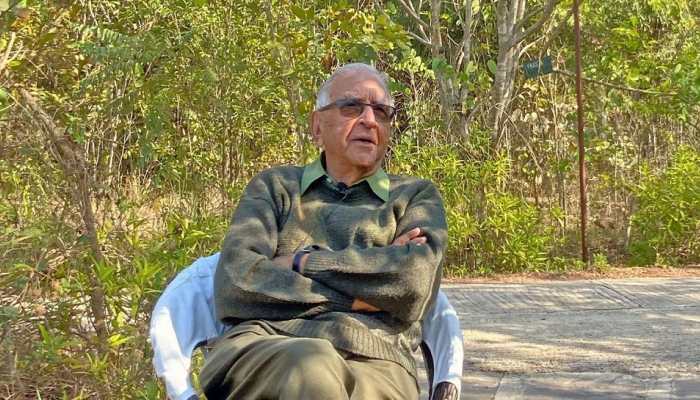Meet Ex-IAS Officer Dr M K Ranjitsinh, The 'Superhero' Who Helped In Bringing Cheetahs To India After 70 Years
Early in the 1970s, India made its first attempt to reintroduce the carnivore. Even then, Dr. M.K Ranjitsingh was the one who spoke with Iran, but once the emergency was declared in 1975 and the Shah of Iran was overthrown in 1979, no further progress could be made in the negotiations.
- It was M.K. Ranjitsinh's tireless efforts that resulted in a ban on the export of snake skins, crocodile skins and furs from the nation.
- He previously received the Lifetime Achievement Award in 2014 for his work in wildlife protection.
- While serving as the state's Forest Secretary, he went on to expand the boundaries of three more national parks in Madhya Pradesh.
Trending Photos
)
Eight cheetahs were transported in from Namibia, signaling the big cat's long-awaited comeback, seven decades after the Asiatic cheetah was listed as extinct in India. During his birthday celebration in 2022, Prime Minister Narendra Modi released eight African cheetahs into the Kuno National Park in Madhya Pradesh. Dr. M.K. Ranjitsinh Jhala, 84, was another individual who was maybe even more delighted on that day than the Prime Minister. Ranjitsinh, a former Madhya Pradesh cadre IAS officer from the 1961 batch, was one of the architects of the 1972 Wildlife (Protection) Act and had a childhood dream of reintroducing cheetahs to the nation. Even though the cheetah was extinct, the former director of Wildlife Preservation included it as a protected species when writing the Wildlife (Protection) Act, 1972.
M.K. Ranjitsinh - The Superhero
If the conservation community in India had to choose a superhero, M.K. Ranjitsinh would undoubtedly be the man of steel. This intellectual genius has spent more than 50 years exploring India's wilderness, developing ground-breaking legislation, inspiring action for lesser-known endangered species, and starting ground-breaking conservation initiatives. Ranjitsinh, a descendant of the former Wankaner royal dynasty of Saurashtra, Gujarat, joined the Indian Administrative Service in 1961. As they say, the rest is history.
M.K. Ranjitsinh - Notable Works
He was in charge of the initial efforts to conserve the highly endangered barasingha deer, Rucervus duvaucelii, from central India. He also made it possible for the first hamlet to be relocated outside of a national park, opening the door for future rehabilitations. He wrote the Wildlife (Protection) Act of 1972 while serving as the Government of India's Deputy Secretary for Forests and Wildlife. This piece of law continues to be India's only hope for wildlife. He created plans to give states financial support from the central government to establish national parks and sanctuaries. He was the first Director of Wildlife Preservation in India under this Act. Later, he contributed to the identification of India's first tiger reserves while serving as the member secretary of the task team that developed Project Tiger, one of the most effective conservation initiatives in the world. Then, from 1975 to 1980, this one-man army provided priceless services to nations in the Asia-Pacific Region while serving as the Nature Conservation Adviser in the UNEP's Bangkok Regional Office. Upon his return to India, he oversaw the notification of 11 sanctuaries and up to eight national parks. While serving as the state's Forest Secretary, he went on to expand the boundaries of three more national parks in Madhya Pradesh.
M.K. Ranjitsinh - Awards And Recognitions
He previously received the Lifetime Achievement Award in 2014 for his work in wildlife protection. He has also held positions as the director of wildlife preservation, chairman of the Wildlife Trust of India (WTI), director general of the WWF Tiger Conservation Programme (TCP), former secretary for forests and tourism in Madhya Pradesh, and regional adviser for nature conservation (Asia & Pacific) for UNEP. He was also in charge of preventing the extinction of the Barasingha in central India. In Madhya Pradesh, Ransitsinh also created eight national parks and fourteen sanctuaries.
M.K. Ranjitsinh - The Protector
It was M.K. Ranjitsinh's tireless efforts that resulted in a ban on the export of snake skins, crocodile skins and furs from the nation. He is as intimidating in the boardroom as he is in the field. He started successful captive breeding and release projects for all three species of Indian crocodilians, being equally fascinated by all wild animals.
M.K. Ranjitsinh - Love For Cheetahs
Early in the 1970s, India made its first attempt to reintroduce the carnivore. Even then, Ranjitsingh was the one who spoke with Iran, but once the emergency was declared in 1975 and the Shah of Iran was overthrown in 1979, no further progress could be made in the negotiations. Since that time, Ranjitsinh and Divyabhanusinh Chavda, a wildlife conservationist, have worked on the rules and strategy for reintroducing cheetahs. The 'African Cheetah Introduction Project in India' was established in 2009, but it wasn't until 2020 that the Supreme Court gave its ultimate clearance. Ranjitsinh was chosen by the SC to lead the expert group formed for the relocation.
There was once a healthy cheetah population throughout India, but according to stories, Maharaja Ramanuj Pratap Singh Deo of Koriya killed the last three huge cats in 1947. The Government of India formally proclaimed the cheetah extinct in 1952 due to overhunting, a lack of available prey, and habitat destruction.
Stay informed on all the latest news, real-time breaking news updates, and follow all the important headlines in india news and world News on Zee News.
Live Tv







)
)
)
)
)
)
)
)
)
)
